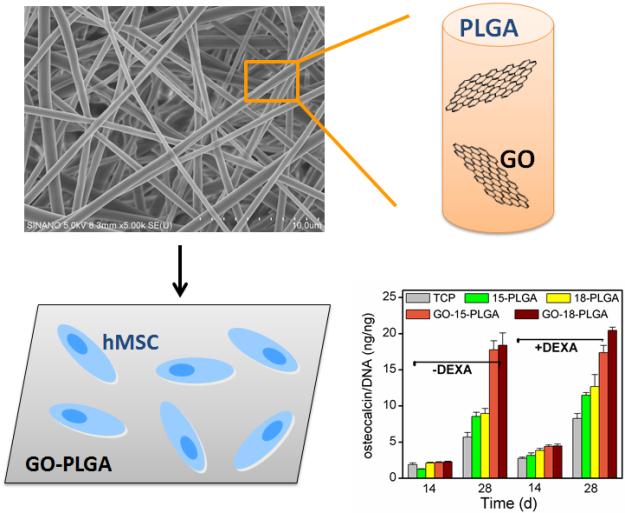Currently, combining biomaterial scaffolds with living stem cells for tissue regeneration is a main approach for tissue engineering. Mesenchymal stem cells (MSCs) are promising candidates for musculoskeletal tissue repair through differentiating into specific tissues. Thus, successfully directing the fate of MSCs through factors and inducers would improve regeneration efficiency.
Recently, a research group led by Professor ZHANG Zhijun at Suzhou Institute of Nano-tech and Nano-bionics, CAS, in collaboration with Professor DAI Jianwu, Institute of Genetics and Developmental Biology, CAS, and Professor SHI Xiangyang, Donghua University, has developed graphene oxide (GO)-doped poly (lactic-co-glycolic acid) (PLGA) nanofiber scaffolds via electrospinning technique and explored their feasibility for the growth and osteogenic differentiation of MSCs. They demonstrated that incorporation of GO into the nanofibers improves the hydrophilicity, and protein/inducer-adsorption of the nanofibers. Moreover, the GO-doped nanofiber scaffolds accelerate the human MSCs (hMSCs) adhesion and proliferation, and induce the osteogenic differentiation towards osteoblast. The GO-incorporated PLGA nanofiber scaffold materials may find applications in tissue engineering and other biomedical fields.
This work was supported by National Natural Science Foundation of China d the Ministry of Science and Technology of China.

Figure: Graphene oxide-incorporated electrospun nanofibrous mats promoted the proliferation and osteogenic differentiation of hMSCs.(IMAGE BY SINANO)
Reference:
Luo, Y.; Shen, H.; Fang, Y. X.; Cao, Y. H.; Huang, J.; Dai, J. W.*; Shi, X. Y.*; Zhang, Z. J.* Enhanced proliferation and osteogenic differentiation of mesenchymal stem cells on electrospun graphene oxide-incorporated poly (lactic-co-glycolic acid) nanofibrous mats, ACS Appl. Mater. & Interfaces, 2015, 7, 6331–6339.
downloadFile
